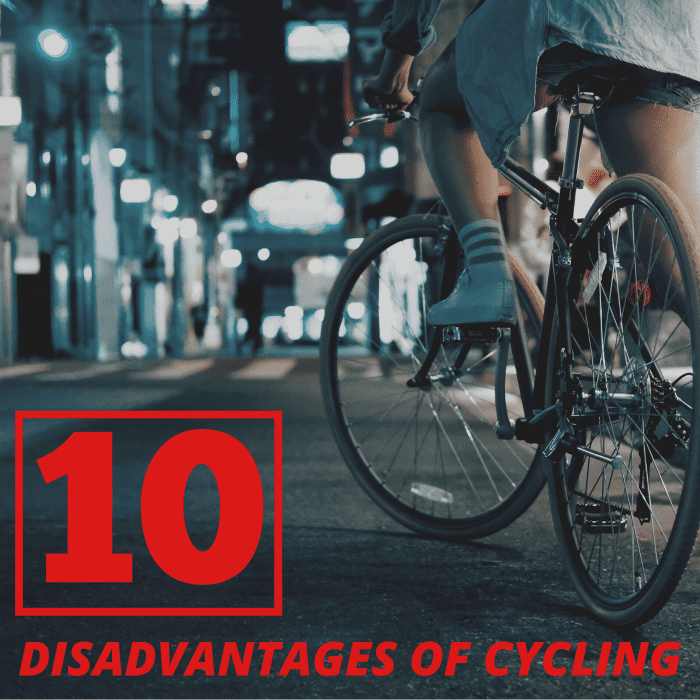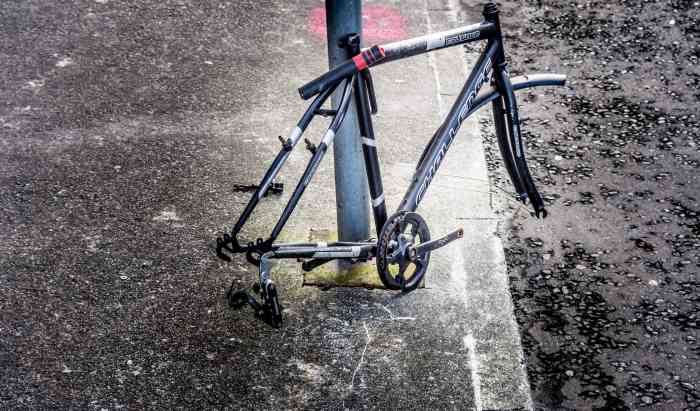What Are the Cons of Riding a Bike?

What Are the Cons of Riding a Bike?
As someone who has ridden a bike for many years, I am fully aware that cycling comes with a myriad of advantages over driving a car. For example, biking is good for your health, it's a relatively inexpensive mode of transport, and it's very environmentally friendly.
However, in this article, I thought that it would be useful to look at some of the negatives of riding a bike, as those aren't often discussed. Cons include vulnerabilities when it comes to dangerous drivers and hazards in the road, as well as some of the limitations of a bicycle compared to a car.
Listed below are the 10 main disadvantages of riding a bike compared to traveling in a car. Each is discussed in detail in the sections that follow.
The 10 Main Downsides to Cycling
- Exposure to the Elements
- Unexpected Expenses
- Dangerous Drivers
- Road Hazards
- Poor Lights
- Lack of Bicycle Lanes and Trails
- Lack of Storage
- Limited Travel Distance
- Inability to Carry Passengers
- Bike Theft
1. Exposure to the Elements
Traveling in a car is sort of like traveling indoors—weather can't reach you. When you cycle, however, there is nothing to protect you from inclement or unpleasant weather. When I lived in England, it was generally the rain and the cold that bothered me most; now that I live in Florida, it is the heat and humidity that cause the most discomfort (not to mention the regular thunderstorms that occur in the hotter months).
Of course, you can dress in climate-appropriate clothing when you ride your bike, but weather changes frequently, and no matter how prepared you are, you'll never get the protection and comfort that comes with being inside a vehicle.
2. Unexpected Expenses
To be a cyclist, all you really need is a bike. But to ride safely, you also need a bicycle helmet, lights, high-visibility clothing, a bell or horn, and a lock to deter thieves.
You may also find that if you use your bike regularly, maintenance costs can add up. Tubes go flat with relative frequency, and even though they aren't particularly pricey, the cost of replacements adds up over time. Bicycles also need regular adjustments, alterations, and repairs, which can be surprisingly expensive if you don't do them yourself.
3. Dangerous Drivers
Dangerous drivers are a cyclist's worst enemy. Even if you ride responsibly and behave cautiously, there is little that you can do to completely avoid the risk of someone running a red light, making a mistake while drunk behind the wheel, or not paying attention to the road because they are distracted by a cell phone.
Of course, dangerous drivers pose a threat to all road users, but they pose a particular threat to cyclists, who are much more vulnerable than car or truck drivers. What would be a minor bump for a car could easily be a fatal accident for a cyclist.
Due to the sheer amount of physical exposure that comes with cycling, any collision can easily result in serious injury. Cars, on the other hand, act as armor to some degree and come with additional safety features like seatbelts and airbags.

4. Road Hazards
Minor obstacles in the road that the driver of a car would barely notice can be disastrous for a cyclist. Fallen tree branches, stones, gravel, mud, puddles, trolly tracks, cracks, oil spills, and small holes in the road can all catapult a cyclist off of their bike in a split second.
This problem is particularly bad at nighttime, as bike lights tend to be relatively weak, especially when compared with those of a motor vehicle. Hazards such as ice, snow, strong winds, or heavy rain can make roads and trails even more treacherous for cyclists, especially at night.
5. Poor Lights
Bicycle lights have improved considerably over the course of my cycling career, but they still don't compare with the power of two motor vehicle headlights. Weaker lights not only make it harder to see when riding in low light; they also make it harder to be seen by motorists, putting cyclists in an even more precarious position.
6. Lack of Bike Lanes and Trails
I am lucky to live in a relatively bicycle-friendly city where there are plenty of provisions for cyclists. Unfortunately, many American towns and cities are less accommodating.
Riding on the open road can feel dangerous, and many car and truck drivers see cyclists as irritations that don't belong on the road rather than viewing them as other commuters that should be respected. Purpose-built trails and paths that are separate from roadways are safer and more relaxing for cyclists and can help pacify drivers, but dedicated bike paths like these can be few and far between.

7. Lack of Storage
Bicycles are great devices for getting one person from A to B, but if you want to carry more than fits into a basket, backpack, or a couple of panniers, you're likely out of luck. This can mean making multiple trips to the store or finding an alternative transportation method if you need to move a larger item like a TV or area rug.
Some cyclists attach trailers to the backs of their bikes to increase storage capacity, but doing so sacrifices speed and aerodynamics and can make the cycling process more clunky and less fun.
8. Limited Travel Distance
Everyone has their limits when it comes to recreational cycling. Biking requires physical effort and endurance, and going uphill can be especially taxing.
Although the terrain is generally flat where I am in Florida, I am reluctant to travel anywhere that takes more than 30 or 40 minutes, especially in the hotter months, as when I do, I end up feeling overheated and sweaty. With faster travel speeds and climate controls, motorized road vehicles don't have these limitations.
9. Inability to Carry Passengers
Another limitation of bicycles is that (in most cases) you can't carry any passengers. Situations may occur where you might want to give someone a ride or collect someone on your way to a gathering, but you can't if you are on your bike. Also, to go anywhere as a group, everyone has to have their own individual bicycle. Of course, there are tandem bikes and child trailers, but riding tandem and hauling trailers both come with their own challenges.
10. Bike Theft
Most city-dwelling cyclists that I know (including myself) have had at least one bike stolen. This problem can be particularly bad in college towns, where thieves have plenty of opportunities to both steal and sell bicycles. In most cases, it's a good idea to keep your bike secure and insure it. I personally just avoid riding my more expensive bike in city areas at all for fear of it being taken.
Even high-quality U-locks aren't infallible, and even if your lock protects your frame, someone can still steal other components of your bike with relative ease if they carry a few simple tools. Seats, bike lights, handlebars, wheels, and pedals can all be removed in less than a minute.
This content is accurate and true to the best of the author’s knowledge and is not meant to substitute for formal and individualized advice from a qualified professional.
© 2018 Paul Goodman

Comments
Post a Comment